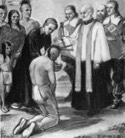Peake - Stiles - Person Sheet
Peake - Stiles - Person Sheet
NameTayac (Chief) KITTAMAQUUND 
 228
228

 228
228BaptismJul 5, 1640, MD
Misc. Notes
By 1600, incursions by the Susquehannock and other Iroquoian peoples from the north had almost entirely destroyed many of the Piscataway and other Algonquian settlements above present-day Great Falls, Virginia on the Potomac River. The villages below the fall line survived by banding together for common defense. They gradually consolidated authority under hereditary chiefs who exacted tribute, sent men to war, and coordinated the resistance against northern incursions and rival claimants to the lands. A hierarchy of places and rulers emerged: hamlets without hereditary rulers paid tribute to a nearby village. Its chief, or werowance, appointed a "lesser king" to each dependent settlement. Changes in social structure occurred and religious development exalted the hierarchy. By the end of the 16th century, each werowance on the north bank of the Potomac was subject to the paramount chief: the ruler of the Piscataway known as the Tayac.
The English explorer Captain John Smith first visited the upper Potomac River in 1608. He recorded the Piscataway by the name Moyaons, after their "king's house", i.e., capital village or Tayac's residence, also spelled Moyaone. Closely associated with them were the Nacotchtank people (Anacostans) who lived around present-day Washington, DC, and the Taux (Doeg) on the Virginia side of the river. Rivals and reluctant subjects of the Tayac hoped that the English newcomers would alter the balance of power in the region.
In search of trading partners, particularly for furs, the Virginia Company, and later, Virginia Colony, consistently allied with enemies of the settled Piscataway. Their entry into the dynamics began to shift regional power. By the early 1630s, the Tayac's hold over some of his subordinate werowances had weakened considerably.
But, when the English began to colonize what is now Maryland in 1634, the Tayac Kittamaquund managed to turn the newcomers into allies. He had come to power that year after killing his brother Wannas, the former Tayac.[19] He granted the English a former Indian settlement, which they renamed St. Mary's City after their own monarch.
The Tayac intended the new colonial outpost to serve as a buffer against the Iroquoian Susquehannock incursions from the north. Kittamaquund and his wife converted to Christianity in 1640 by their friendship with the English Jesuit missionary, Father Andrew White, who also performed their marriage.[19] Their only daughter Mary Kittamaquund became a ward of the English governor and his sister-in-law, colonist Margaret Brent, both of whom held power in St. Mary's City and saw to the girl's education, including learning English.
Mary Kittamaquund, daughter of the Tayac (Paramount Chief) of the Piscataway Indians, was born in Maryland probably about 1631.[i] Her father ruled over as many as 7,000 people between the Potomac and Patuxent Rivers.[ii] Following about six months of dialogue and study with Jesuit Missionary Father Andrew White, Mary’s father converted to Christianity and was baptized on July 5, 1640.[iii] Soon after February 15, 1640/1, Mary too was baptized, and her father sent her to the English settlement called St Mary’s City, near the mouth of the Potomac River, to be educated by Governor Leonard Calvert and his sister-in-law, Margaret Brent.[iv]
The English explorer Captain John Smith first visited the upper Potomac River in 1608. He recorded the Piscataway by the name Moyaons, after their "king's house", i.e., capital village or Tayac's residence, also spelled Moyaone. Closely associated with them were the Nacotchtank people (Anacostans) who lived around present-day Washington, DC, and the Taux (Doeg) on the Virginia side of the river. Rivals and reluctant subjects of the Tayac hoped that the English newcomers would alter the balance of power in the region.
In search of trading partners, particularly for furs, the Virginia Company, and later, Virginia Colony, consistently allied with enemies of the settled Piscataway. Their entry into the dynamics began to shift regional power. By the early 1630s, the Tayac's hold over some of his subordinate werowances had weakened considerably.
But, when the English began to colonize what is now Maryland in 1634, the Tayac Kittamaquund managed to turn the newcomers into allies. He had come to power that year after killing his brother Wannas, the former Tayac.[19] He granted the English a former Indian settlement, which they renamed St. Mary's City after their own monarch.
The Tayac intended the new colonial outpost to serve as a buffer against the Iroquoian Susquehannock incursions from the north. Kittamaquund and his wife converted to Christianity in 1640 by their friendship with the English Jesuit missionary, Father Andrew White, who also performed their marriage.[19] Their only daughter Mary Kittamaquund became a ward of the English governor and his sister-in-law, colonist Margaret Brent, both of whom held power in St. Mary's City and saw to the girl's education, including learning English.
Mary Kittamaquund, daughter of the Tayac (Paramount Chief) of the Piscataway Indians, was born in Maryland probably about 1631.[i] Her father ruled over as many as 7,000 people between the Potomac and Patuxent Rivers.[ii] Following about six months of dialogue and study with Jesuit Missionary Father Andrew White, Mary’s father converted to Christianity and was baptized on July 5, 1640.[iii] Soon after February 15, 1640/1, Mary too was baptized, and her father sent her to the English settlement called St Mary’s City, near the mouth of the Potomac River, to be educated by Governor Leonard Calvert and his sister-in-law, Margaret Brent.[iv]

